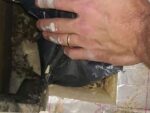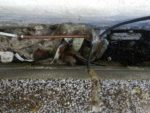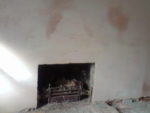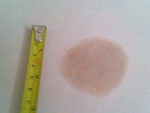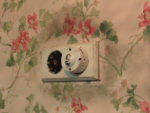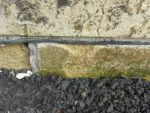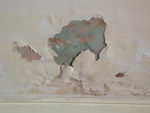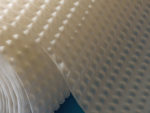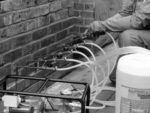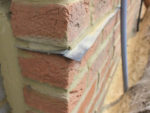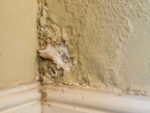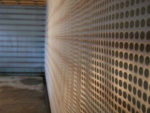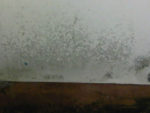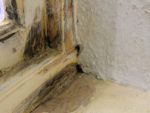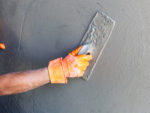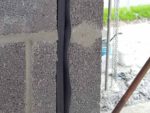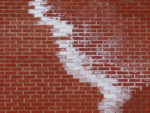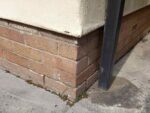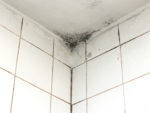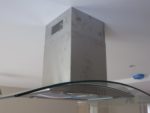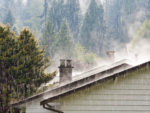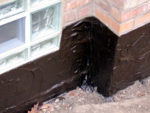As anyone that lives in the UK knows, we have quite a humid climate and what most would also agree – a fair amount of rain!
With this in mind it’s inevitable that some homes and properties will suffer from the damp, mould and condensation issues.
The damp and humid conditions are not necessarily the sole cause of damp problems, more just the initial starter.
These issues themselves are normally caused when water and moisture are allowed to enter a given property through either cracked or broken mortar joints, broken roof tiles, faulty guttering allowing water to constantly pour down walls, faulty lead flashing etc….
Once water and moisture is allowed in, it then travels as far as it can before resting and if tis is coupled with poor ventilation and air flow it rarely dries out causing the affected area to be constantly damp.
This is turn then creates cold spots (areas that may be colder than any surrounding surface areas) and with temperatures increasing and decreasing the affected areas (due to heating turning on and off, cooking etc….) can easily cause condensation to form and inevitably black mould.

Black mould forming on wall due to damp and lack of ventilation
As we have discussed, the normal cause of the above issues is water getting in to a property somehow. If a repair is then made to fix the initial issue then this will indeed fix the root cause, but if adequate ventilation is not also added to the mix to allow the damp areas to dry out, the issues will unfortunately remain.
Despite the obvious detrimental effects placed on the building itself through the constant exposure to water and moisture, there can also be health issues to think about.
Black mould and other moulds have been linked to many health issues including breathing issues such as asthma and also allergic reactions. Some black mould species have also been known to produce toxic spores!
With all of the above in mind you can see that dealing with damp and mould issues really is an important job!
Most Common Causes of Damp and Mould
As we have already discussed, there can be a number of causes of for water entering a property, here follows some of the most common:
Damp Proof Course
The damp proof course in a building is normally located around 150mm from ground level and its sole purpose is to prevent damp from travelling from ground level, up a wall.
Damp courses vary in what their made from depending on the age of the property – traditionally they used to be slate or a similar material, but in more modern properties they tend to be plastic.
If the damp course is broken or pierced then water can travel upwards, likewise if it is bridged (something across the cavity space, joining the outer skin to the inner skin) then water can travel to the inner skin of your property causing issues, so all areas of the damp proof course needs checking.
Broken and Cracked Mortar Joints
Most properties are constructed using a cavity wall system; 1 outer brick skin, a cavity gap and then 1 inner brick skin. The outer brick skin provides a weather shield to the inner brick skin and the cavity gap prevents cold, moisture etc…. form reaching the inner skin.
The bricks or blocks that form the outer skin provide most of the protection along with the mortar that joins the bricks together. If this mortar becomes broken and cracked then water, moisture and cold can easily access the cavity area.
You should check all of your mortar joints in detail to ensure that they are intact and that nothing can get in.
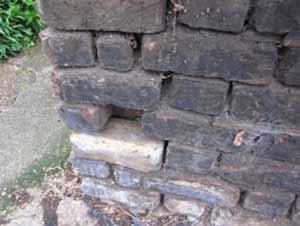
Mortar and pointing in wall badly damaged and fallen out
Roof Tiles and Flashing
In a similar manner to your walls, your roof protects the top of your property. Roof tiles, roofing felt, rubber membranes, lead flashings around chimneys or roof valleys etc…. prevent rain water and moisture from getting in to your property.
As access to your roof area is not an easy task then any issues can easily go unnoticed until they manifest themselves in the form of stains on the ceiling or damp marks on the walls.
One other important thing to note is that water will always find a way to travel and although your damp issue may be that you have damp spots on the inner wall of a ground floor room, it may seem impossible that this is due to some broken flashing around the chimney but this could entirely be the case due to the fact that water has travelled to that point.
You will need to check your roof in detail in the case of any damp problems. There are several ways this can be done, the obvious being getting up there and having a look. This in itself can be quite a dangerous task so it’s really only for those that feel confident they can do this safely or do such things regularly so will be well voiced in the safety considerations involved.
If you do not feel confident in doing the above then there are other options:
- Use Binoculars/Telescope: A decent pair of binoculars or a telescope can allow you to check your roof in great detail and identify any issues that there may be
- Use a Drone: With the rise in drone technology it is now possible to purchase, hire or possible borrow a small drone with a very good quality video camera. This would allow you go get very close to your roof and check it in fine detail
Additionally, you should also check your guttering for splits, cracks and damage. Broken guttering can cause water run over the face of external walls and if this happens regularly then over time the water can soak through.
Other Information on Damp and Mould
As we have discovered, there can be quite a few causes of damp and mould issue in a given property and each potential area of cause needs to be inspected, checked and repaired if it’s found to be defective.
We have a great deal of information on damp and mould, woodworm and rot issues and also condensation problems and causes that can be found here in our damp section.
If you are looking for speciific information on damp and mould problems and causes, see our project on fixing damp and mould issues here.

